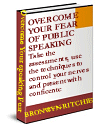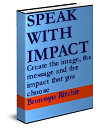Pivotal Public Speaking
|
My Best Presentation Tricks
Giving presentations can be a complete and utter thrill. Too bad attending them can be a complete and utter bore. If you are on the giving side, I want to offer you up a collection of my best presentation tricks to date. Iíve written on presentation and the storytellerís promise before at my site. Iíve written what has oddly become my top-rated post of all time, Bring out your inner David Lee Roth. This will draw from these concepts and more. Stories and Characters With few exceptions, a presentation is an opportunity for you to tell a story to an audience. You have the conch shell. You are the wielder of the fire stick. And your audience enters into a relationship with you from the moment they choose to sit in your presence. (Hereís a hack- what if you gave a presentation and provided no chairs? What would a standing audience look and feel like?) As such, your audience is expecting a story. A story has a beginning, a middle, and an end. Youíve heard this before, and you understand, but apply it to your presentation. And no, I donít mean, ďHereís what weíll talk about, talk-talk, thatís what we talked about.Ē Stories also have characters. So, start your story at the beginning with a character. If youíre describing a product, start with the user of the product. Or start with the person who moves your product from one business to the other. But put PEOPLE in your story. At the beginning, your character should have a problem. Maybe she has too many spreadsheets and not enough linking, and people are starting to give her information in ways that her spreadsheets are overflowing their banks. In the middle, your character meets the new product, a database, and now sheís really excited because the database can do EVERYTHING the spreadsheets were lacking. By the end of the story, your character is poised on all the great new ways the database will save her in the future, and sheís looking forward to applying her new skills to a new challenge. Ads are presentations. Watch TV for a few minutes and see the stories; think about them in terms of a story with a character, a structure, etc. Do you see it? Touch Their Eyes Presentations are not opportunities for people to read in a group setting. Your slides, if you choose to use them, should not be textual orgies. Use visual shorthand. Are you talking about budget numbers? How about a big picture of a cash register, with the numbers showing up as the register tape? If you can turn your information into a visual summation, even if you read actual statistics and numbers out over the presentation of the slide, thatís useful. Remember that a slide deck doesnít have to equal the handout provided after the presentation. You can send people off with a document containing all the textual support of your presentation. But truly, do you think people want to sit around the room and read complex graphs of numbers, huge text dumps regarding a new product, or anything else that requires an intense amount of leaning in and squinting? (Yes, exceptions to this concept exist in abundance, but please consider whether your presentation is the exception, or more likely, is a target for more imagery and fewer words). There are all kinds of great sources for interesting graphics and images to add to your slide deck. Heck, even Flickr offers lots of material thatís licensed for use under Creative Commons. (I use them frequently) A Presentation Doesnít Equal a PowerPoint Side Deck I was once in an argument with someone over the fact that I didnít have slide deck materials to give her. She said I couldnít present without slides. I said that slides were merely one tool. In the end, she wouldnít relent, so I sent her a slide deck with 24 slides of all black background with orange title headers. I knew she would be printing (call me spiteful), and yes, when I got there to present, sheíd dutifully depleted the earth of several ink catridges to be faithful to her documentation bent. You can present without a slide deck. Itís scary, because you are the focus of the audience. They are all staring at you, and every point you make, either causes eyeballs to refocus on you, or every time you lose them, it causes eyeballs to drift away and examine the walls, the ceiling, their BlackBerrys. It becomes much more of a ďlive without a netĒ feeling to have a presentation without a slide deck to serve as backup. Which is why itís really powerful. If you can pull off this kind of presentation, itís often very memorable. People will hold on to the words you used to paint stories in their heads. It will keep their visual memory working, which is why great radio programs can often engage more of our senses than youíd expect. Try it once in a while. You might find it truly terrifying, but you might also see a reward. You are an Entertainer Presenting, even to your coworkers and colleagues, is an entertainment experience. If not, why are you standing there with a room full of people looking at you? You could just send an email, mail out a brochure. The presumption is that thereís something inherent in your presence that people canít get from just browsing the brochure. Most people incorrectly assume that they ship a human along with the presentation merely for the Q&A session that follows. Wrong. This is your opportunity to breathe life into material that might not stand so well on its own. Itís a chance to give a face and a voice to something that might not be easily humanized. (What if youíre selling waste treatment engineering supplies? Iím doubting people can see the ďstoryĒ in that easily). Itís a chance to connect with an audience and give them something that theyíre never going to receive directly from the product or service or material youíre presenting about. Why present about your last quarterís numbers? Because either youíre presenting the proud face of a groupís accomplishment, or youíre giving the story and the news behind why you didnít measure up. Entertainers are strong on giving their stories life, but they are also strong on reading the room. An entertainer will know whether the people in the audience are being bored by something youíre presenting, and perhaps theyíll mix it up a bit. This requires work. Again, if all you had to do was send an audio voiceover with the slides, you would. Entertainers, er, presenters, are there to make sure the audience is playing along at the same pace, and that everyone is connecting with the material. It goes back to the relationship I mentioned in the storytelling section. Why Not You? If you think your presentations canít benefit from the above, why not? What line of work are you in that humans donít want to be engaged? What serious business do you conduct that canít be brought to riveting and rapt attention by giving your information a flair? Do you doubt for a moment that even the most grave information you see on the news isnít built into a presentation? Even there, the aspect of storytelling and connection to the audience through a human character is the point that brings back great feedback and connection. Humans want to connect. They are built to want to belong. A great presentation is a fire to gather around and share an experience. Use every opportunity you have to present to tell a story, and I guarantee that you will be sought out to present material of more and more importance. As a presenter, you have the opportunity to give a rockstar performance that gives people something to think about. Why not? Are you saving your performance for some other venue? ĖChris Brogan writes about self-improvement and creativity at [chrisbrogan.com]. He recently launched the Grasshopper Factory.
|



